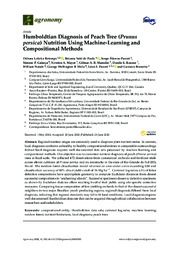Humboldtian Diagnosis of Peach Tree (Prunus persica) Nutrition Using Machine-Learning and Compositional Methods.
Humboldtian Diagnosis of Peach Tree (Prunus persica) Nutrition Using Machine-Learning and Compositional Methods.
Summary: Regional nutrient ranges are commonly used to diagnose plant nutrient status. In contrast, local diagnosis confronts unhealthy to healthy compositional entities in comparable surroundings. Robust local diagnosis requires well-documented data sets processed by machine learning and compositional methods. Our objective was to customize nutrient diagnosis of peach (Prunus persica) trees at local scale. We collected 472 observations from commercial orchards and fertilizer trials across eleven cultivars of Prunus persica and six rootstocks in the state of Rio Grande do Sul (RS), Brazil. The random forest classification model returned an area under curve exceeding 0.80 and classification accuracy of 80% about yield cutoff of 16 Mg ha-1 Centered log ratios (clr) of foliar defective compositions have appropriate geometry to compute Euclidean distances from closest successful compositions in 'enchanting islands'. Successful specimens closest to defective specimens as shown by Euclidean distance allow reaching trustful fruit yields using site-specific corrective measures. Comparing tissue composition of low-yielding orchards to that of the closest successful neighbors in two major Brazilian peach-producing regions, regional diagnosis diered from local diagnosis, indicating that regional standards may fail to fit local conditions. Local diagnosis requires well-documented Humboldtian data sets that can be acquired through ethical collaboration between researchers and stakeholders.
Publication year: 2020
Types of publication: Journal article
Keywords: Porta Enxerto, Prunus, Pêssego
Observation
Some of Embrapa's publications are published as ePub files. To read them, use or download one of the following free software options to your computer or mobile device. Android: Google Play Books; IOS: iBooks; Windows and Linux: Calibre.
Access other publications
Access the Agricultural Research Database (BDPA) to consult Embrapa's full library collection and records.
Visit Embrapa Bookstore to purchase books and other publications sold by Embrapa.

